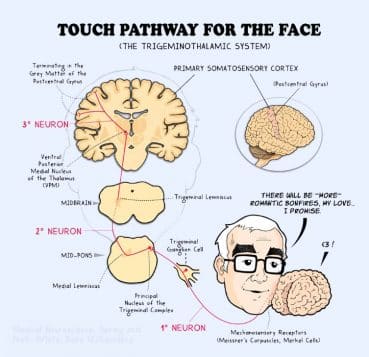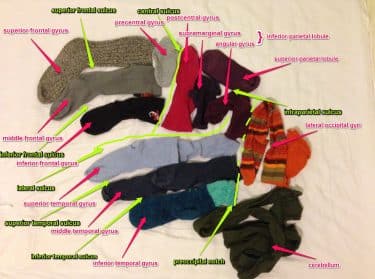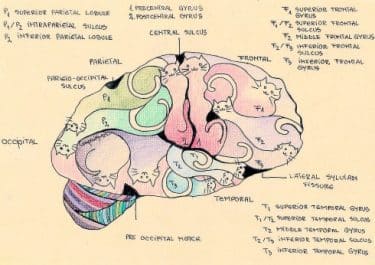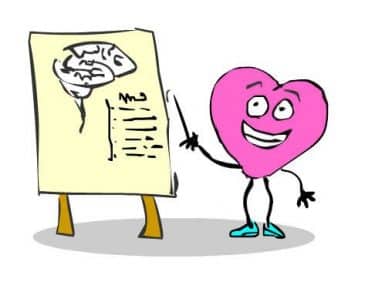by: Ellen Vos-Wisse, Marina Buryak, Indira Biel and Kevin Park (course Mentors Medical Neuroscience)

Introduction
Taking a well-designed MOOC (Massive Open Online Course) can have a life-changing effect, such as one can read about in the following article:
Eric Ferreri (October 11, 2016):
Len White on building an online community – one hashtag at a time
DukeTODAY.
Prof. White met an unfamiliar young man outside his office one day. The man knew White through the MOOC Medical Neuroscience. The course inspired the man so much that he left his native China (where he was a medical student) to come to the US seeking neurosurgery opportunities. He was outside Dr. White’s door that day simply to express his gratitude.
“He realized he wanted to become a neurosurgeon, and he did not have that idea before he took the course,” prof. White says. “It was a powerful moment.”
Affective Learning
In education Bloom’s Taxonomy is used to analyze the learning process. Bloom’s Taxonomy is a set of three hierarchical models used to classify educational learning objectives. The three domains cover learning objectives in cognitive, affective and sensory domains. Affective learning pertains to attitudes, emotions, motivations, and feelings. MOOCs often have strong learning goals in the cognitive domain. Consequently learning goals in the affective domain are less apparent.
Research on learning goals in Massive Open Online Courses (MOOCs) has been published by Kun Li (Online Course Builder at Duke University, Center for Instructional Technology) and Kim Manturuk (Manager of Program Evaluation at Duke University).
Kun Li and Kim Manturuk (June 19, 2017):
Pathways for Affective Learning in Massive Open Online Courses.
EDUCAUSE Review
Affective Learning Pathways in MOOCs
Researchers have concluded that instructors who want to influence attitude should build both a teaching presence and what they termed a “social presence” into the course.
In educational research it has been found that students are more motivated when they participate in a video-based online study group; hence social learning strengthens the learning process.
Li and Mantaruk state that MOOCs can generate affective learning by four pathways:
- Sharing instructor enthusiasm
- Engaging with controversial topic
- Exposure to diversity
- Experiencing innovative teaching approaches
Social presence of Prof. White in Medical Neuroscience
In the opinion of Mentors of Medical Neuroscience the social presence of the teacher is not only important in attitude change but also very inspiring in the cognitive learning process.
Prof. White tries to give learners a personal experience by the setting of the lectures. In
Leonard White (July 8, 2015):
Medical MOOCs: Lessons Learned from the Trenches of Medical Education
The EvoLLLution
we read:
“From the inception of my MOOC, I’ve tried to give students the experience of a private tutorial—as if they have come to my office for help or scheduled a meet-up somewhere on campus. To achieve this aim, I never record a live lecture just so that it can be repurposed for the MOOC[..] I have also avoided “green screen” (weather-person) videographic techniques, because I want students to see me in context (simulating the private tutorial experience). So behind me in the picture-in-picture window, students see my laboratory, my academic office, my living room, my backyard, the Duke Forest, and enough of campus to get a feel for the general environs of Duke University.”
The Medical Neuroscience Learning Community
The building of an online learning community has always received a lot of attention in the course. In one of the tutorials Prof. White advises learners to “learn socially” tutorial video Your Part! at 11:04). Medical Neuroscience has a very active learning community. See the page on the learning community on this supportive website (built by a learner and now Mentor) of the course and the video Social Brains in Medical Neuroscience from a learners perspective. There is an active Course forum, a Facebook page and when Google Hangouts were technically possible there have been very useful meetings from Prof. White and learners.
Instructor enthusiasm in Medical Neuroscience
Prof. White is very passionate about the brain. Students are inspired by that and share that enthusiasm in their work on assignments. One example is the “Touch Pathway for the face by Jonathan Andrew (see figure above) which clearly shows Prof. White and his affection for the human brain. Brain images produced in the course are enthusiastically shared by the learners, take a look at the examples below. (see more examples on the page visualize your knowledge on this website).


Innovative teaching approaches in Medical Neuroscience
Li and Manturuk had access to the evaluation of the course by learners. An innovative element in our course is that Prof. White films many lectures in the laboratory using actual human brains. Li and Manturuk share students’ views:
- “Really interesting course. I loved the videos ‘in the lab’ with the human brains. I’ve never seen them before.”
- “I enjoyed a lot the anatomy classes with brain specimens, this was new for me in online courses. I also enjoyed a lot prof. White’s [the instructor] approach of explaining experiments showing the methodology and explaining very clearly the data. The course was [a] great experience for me, and I plan to apply a lot of what I’ve [seen] here in my future work as a professor.”
- “This was an excellent course; it was well [organized], well run, and employed solid pedagogy. I enjoyed the lectures and lab demonstrations and especially [appreciated] the tutorial notes and images… I don’t believe MOOCs are a panacea for higher education’s woes and I don’t believe they are appropriate for everyone, but I am glad I have been able to participate in such a great one so that I know what can be accomplished.”
Conclusions
Li and Manturuk conclude that MOOCs can be a source of innovative teaching and a pathway for affective learning. “In every MOOC that Duke has offered, many learners volunteered unsolicited examples of affective learning. These typically fell into one (or more) of the following three categories: (1) the course gave them a more favorable attitude toward a subject that they previously found uninteresting or difficult; (2) the instructor personally inspired them; or (3) they were motivated to make a positive life or career change.”
Finally the authors of this post conclude that the course Medical Neuroscience is a good example of the power of affective learning in a MOOC. In short it inspires a solid, international community of learners in an online medical study.
